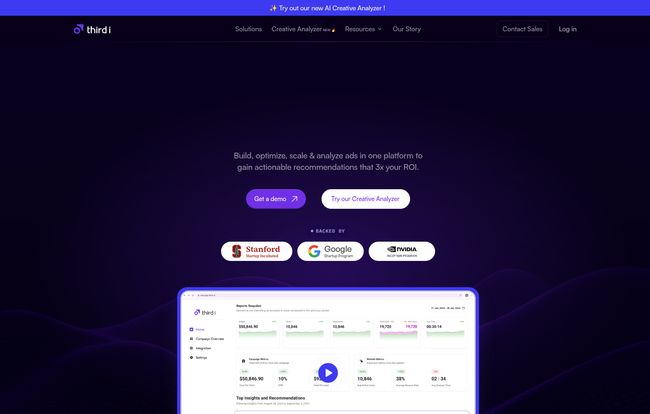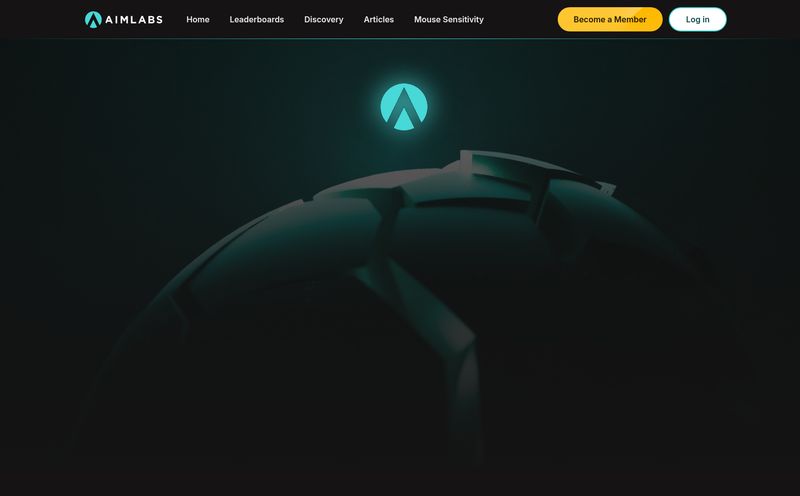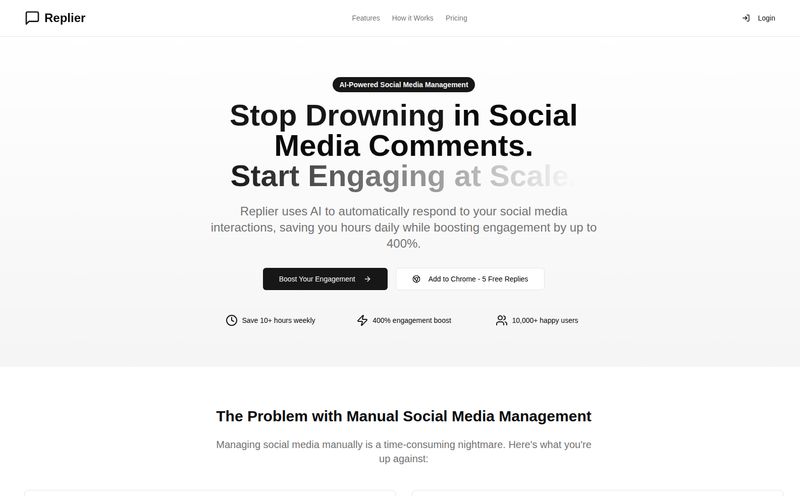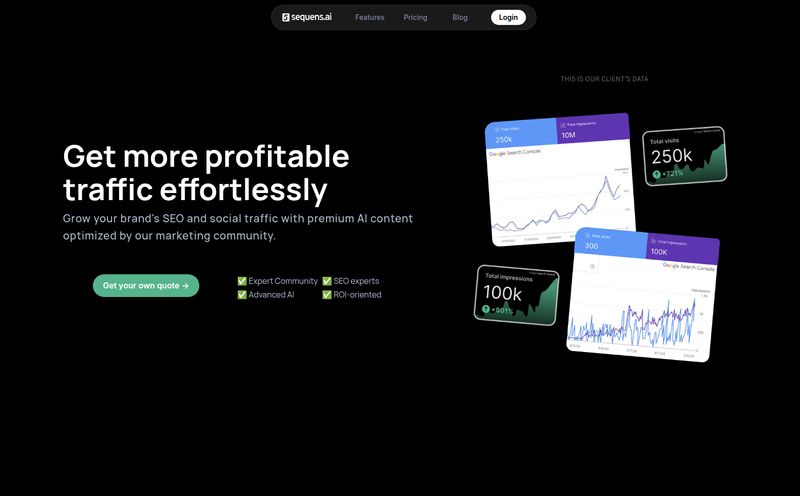If your browser looks anything like mine on a typical Tuesday, you’ve got at least fifteen tabs open. Google Analytics is in one, Facebook Ads Manager in another, your email platform’s dashboard, Google Trends, maybe a spreadsheet you’ve been meaning to update for three weeks… it’s a mess. A beautiful, data-rich, utterly chaotic mess. And for years, we’ve just accepted it as the cost of doing business in the digital marketing world.
We're drowning in data, but we're starving for wisdom. We know the answers are in there somewhere, but finding them feels like trying to find a specific needle in a giant, ever-growing haystack made of other needles. So when a platform like third i comes along, promising to be an AI-powered growth marketing platform that simplifies everything, you can’t blame me for being a little skeptical. And also… incredibly curious.
Is this just another shiny object syndrome distraction, or could it actually be the smart, AI-powered copilot we need to navigate the madness? I decided to take a good, long look.
What Exactly is third i, Anyway?
At its core, third i pitches itself as your marketing “source of truth.” That’s a bold claim. I've seen a dozen platforms make that same promise. But where third i seems to differ is that it’s not just another dashboard that pulls all your data into one place. It aims to be a brain that sits on top of that data.
Imagine all your marketing channels are people in a room. Google Ads is shouting about CPC, Facebook is going on about engagement rates, and your CRM is muttering about lead quality. Third i is supposed to be the moderator in the middle who listens to everyone and then says, “Okay, fascinating points. But here’s what we’re actually going to do to make more money.” It’s designed to turn all that noise into a clear, actionable strategy.
They toss around a pretty impressive number: “3x marketing growth.” As an SEO and performance marketer, I’ve learned to take big numbers like that with a grain of salt. But the idea of an AI that connects the dots for me? That’s compelling. That’s the dream, right?
The Core Intelligence Features: Breaking Down the Brain
The platform is built on a few key pillars they call “Intelligence.” It sounds a bit like marketing-speak, but when you break it down, it starts to make sense. It’s about applying AI to different parts of the marketing funnel.
Customer Journey Intelligence
Ever tried to explain a modern customer journey to someone outside of marketing? It’s impossible. Someone sees a TikTok, forgets about it, gets retargeted on Instagram a week later, Googles your brand name, clicks an ad, reads three blog posts, and then finally buys. Trying to attribute that sale to a single touchpoint is a fool’s errand. This feature is designed to map that messy, nonlinear path, showing you how different channels actually work together.
Campaign & Strategy Intelligence
I like to think of these two as a pair. Campaign Intelligence is your rearview mirror—it analyzes what you’ve already done, telling you what worked, what flopped, and why. It's about learning from the past.
Strategy Intelligence, on the other hand, is the GPS. It takes those learnings and combines them with market trends to suggest future moves. It’s about answering the question, “Okay, what’s next?” This proactive element is what separates a simple reporting tool from a genuine strategy partner.
The AI Creative Analyzer: This Changes Things
Alright, this is the feature that really got my attention. Let’s be honest, so much of creative testing feels like voodoo. We swap a headline, change a button color, use a picture of a dog instead of a cat, and hope for the best. It’s expensive, time-consuming, and often inconclusive.
The AI Creative Analyzer from third i aims to take the guesswork out of it. The idea is that you can feed it your ad creatives—images, videos, copy—and the AI will analyze them for elements that are likely to drive performance. It moves the analysis from after you’ve spent $10,000 to before you’ve spent a dime. If this works as advertised, it's not just an improvement; it's a fundamental shift in how we approach creative development. It could save teams an incredible amount of time and money.

Visit third i
Beyond the Buzzwords: How Does It Actually Work?
So, you get all these fancy insights. Now what? This is where the “Full-Funnel Activation” and “Cross-channel Automation” come into play. It’s about closing the loop between insight and action. The platform doesn't just tell you, “Hey, your ads on Platform X are underperforming with Audience Y.” It gives you concrete recommendations and, in some cases, can help you automate the fix.
This is where I see the real human value. A tool like third i isn’t here to replace skilled marketers. I’ve seen that fear pop up in a few forums. I think it’s the opposite. It’s here to take away the soul-crushing, repetitive, data-entry parts of the job. It handles the number crunching so the human marketer can do what they do best: think about the big picture, understand the customer on an emotional level, and craft a compelling brand story. It’s about augmenting our abilities, not automating us out of a job.
Let's Talk Turkey: The Pricing & Who It's For
Of course, none of this matters if it’s priced for another planet. The pricing structure seems pretty thought-out and tiered for different types of businesses. I appreciate the transparency.
| Plan | Price | Best For |
|---|---|---|
| Trial | Free (14 days) | Curious marketers wanting to test the core features with Facebook & Google Ads. |
| Essential | $249 / month | Founders, growing businesses, and in-house marketers ready to connect all their channels and get serious about growth. |
| Custom | On Request | Larger enterprises or agencies with complex needs, requiring custom integrations and dedicated support. |
The Essential plan at $249/month seems like the sweet spot for a huge chunk of the market. If you're a startup that's found product-market fit and is now pouring money into ads, or a small marketing team that feels constantly overwhelmed, this seems tailor-made for you. The 30-minute weekly expert call included in that plan is also a pretty nice value-add.
The Not-So-Shiny Parts (The Cons)
Alright, no tool is perfect, and it would be dishonest to pretend otherwise. Based on the documentation and my own experience with similar platforms, there are a few realities to consider.
First, the initial setup. Connecting all your marketing APIs and data sources is never a one-click affair. It's like assembling IKEA furniture; you know the end result will be great, but there's going to be a bit of frustration and manual work upfront. You have to be ready for that.
Second, and this is the big one: the platform's effectiveness hinges entirely on the quality of your data. This is the classic “garbage in, garbage out” problem. If your UTM tracking is a disaster and your conversion pixels are firing all over the place, third i won't magically fix it. It will just give you beautifully-formatted, AI-generated bad advice. You need to have your data hygiene in a reasonably good place first.
Finally, there's a defnite learning curve. This isn't your grandma's social media scheduler. It's a sophisticated tool with a lot of moving parts. Expect to spend some real time in the first few weeks learning the interface and understanding how to interpret the recommendations. It’s an investment, not an instant fix.
My Final Verdict: Is third i Your Next Marketing Hire?
So, we circle back to the original question. Is third i worth it? After digging in, my answer is a solid maybe, leaning towards yes—for the right kind of team.
This tool isn't for the absolute beginner who is still figuring out what CPC stands for. It’s for the marketer who is data-rich but insight-poor. It's for the team that has scaled to a point where the chaos is becoming unmanageable and spreadsheets are starting to break. It's for the founder who knows they need to be more data-driven but doesn't have a full team of analysts.
For my money, the true power lies in its ability to centralize intelligence and make creative analysis less of a dark art. It’s about shifting from a reactive posture—“Oh no, RoAS dropped last week, what happened?”—to a proactive one—“The AI suggests our next campaign should focus on short-form video for this audience segment to maximize impact.”
It's not a new team member, but it might just be the perfect tool to make your existing team ten times more effective. And in this market, that might be even better.
Frequently Asked Questions
How does third i customize its components?
The platform offers a flexible interface. Especially on the Custom plan, you can work with their team to build custom dashboards, set up specific integrations, and align the reporting with your unique brand identity and KPIs.
Is there a free trial for third i?
Yes, there is. They offer a 14-day free trial that lets you connect Facebook and Google Ads to test out the core features, including basic AI recommendations and the analytics dashboard. It's a great way to get a feel for the platform before committing.
How are platform updates delivered?
Like most modern SaaS platforms, updates are rolled out automatically and continuously. You don't have to worry about manual installations. New features and improvements should appear in your dashboard as they are released.
What kind of support options are available?
Support varies by plan. The Essential plan includes a 30-minute weekly expert call, which is great for ongoing strategy. The Custom plan offers a dedicated marketing expert and white-glove support. All users typically have access to standard email or chat support and a knowledge base.
Can third i integrate with my existing CRM?
While the standard plans focus on media channels, the Custom plan is designed for this. They mention custom integrations, which would typically include major CRMs like HubSpot, Salesforce, or others to get a full view of the customer lifecycle.
Is third i suitable for a solo founder?
It could be, especially a solo founder with a strong marketing budget. The Essential plan is designed for founders and marketers. If you're spending significantly on ads across multiple channels and struggling to connect the dots, the $249/month could easily pay for itself in improved efficiency and ad spend.
A Smarter Way Forward
Look, the marketing world isn't getting any simpler. More channels, more data, and more competition are on the horizon. Sticking with the old way—the fifteen browser tabs and the gut-feel decisions—is a recipe for falling behind. Tools like third i represent a new path. They're not magic wands, and they require a commitment to clean data and a willingness to learn. But they offer the potential to finally tame the chaos, to find the signal in the noise, and to equip marketers with the intelligent insights needed to not just survive, but to truly grow.
Reference and Sources
- third i Official Website
- third i Pricing Page
- The Marketing AI Institute - For further reading on AI's role in the industry.



